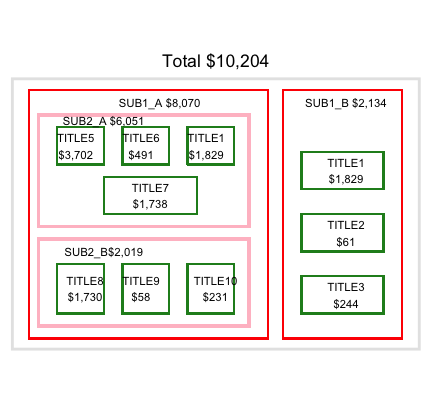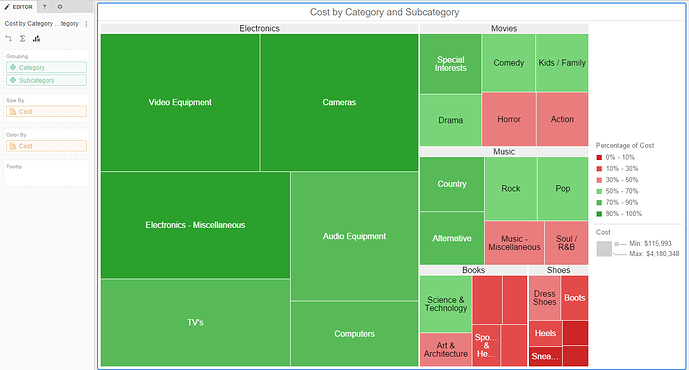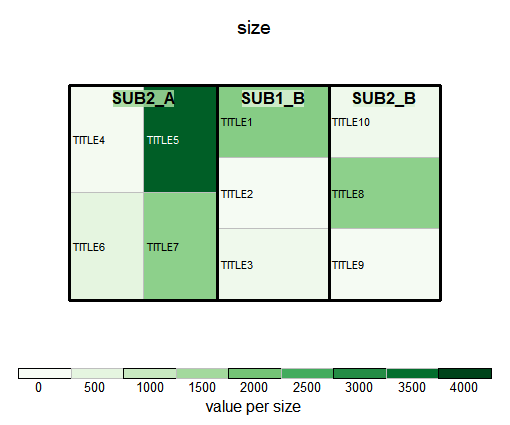There is nothing about this graphic that I can recommend.
library(dplyr)
#>
#> Attaching package: 'dplyr'
#> The following objects are masked from 'package:stats':
#>
#> filter, lag
#> The following objects are masked from 'package:base':
#>
#> intersect, setdiff, setequal, union
library(ggplot2)
e <- data.frame(
head2 = c(rep("SUB1_A", 7), rep("SUB1_B", 3)),
head3 = c(rep("SUB2_A", 4), rep("SUB2_B", 3), paste0("TITLE", 1:3)),
head4 = c(paste0("TITLE", 4:10), rep(NA, 3)),
value = c(120, 3702, 491, 1738, 1730, 58, 231, 1829, 61, 244)
)
# subtotals
titles <- e |>
group_by(head2, head3, head4) |>
summarise(subtotal = sum(value, na.rm = TRUE))
#> `summarise()` has grouped output by 'head2', 'head3'. You can override using
#> the `.groups` argument.
subs <- e |>
group_by(head2, head3) |>
summarise(subtotal = sum(value, na.rm = TRUE))
#> `summarise()` has grouped output by 'head2'. You can override using the
#> `.groups` argument.
smalls <- e |>
group_by(head4) |>
summarise(subtotal = sum(value, na.rm = TRUE))
smalls <- smalls[complete.cases(smalls), ]
bigs <- e |>
group_by(head2) |>
summarise(subtotal = sum(value, na.rm = TRUE))
# sort in numeric order
smalls[8,] <- smalls[1,]
smalls <- smalls[-1,]
ITEM0 <- paste0("Total $",prettyNum(sum(subs[3]),big.mark = ","))
ITEM1 <- paste0(bigs[1,1]," $",prettyNum(sum(bigs[1,2]),big.mark = ","))
ITEM2 <- paste0(bigs[2,1]," $",prettyNum(sum(bigs[2,2]),big.mark = ","))
ITEM3 <- paste0(subs[1,2]," $",prettyNum(subs[1,3],big.mark = ","))
ITEM4 <- paste0(titles[1,3],"\n$",prettyNum(titles[1,4],big.mark = ","))
ITEM5 <- paste0(titles[2,3],"\n$",prettyNum(titles[2,4],big.mark = ","))
ITEM6 <- paste0(titles[3,3],"\n$",prettyNum(titles[3,4],big.mark = ","))
ITEM7 <- paste0(titles[8,2],"\n$",prettyNum(titles[8,4],big.mark = ","))
ITEM8 <- paste0(titles[4,3],"\n$",prettyNum(titles[4,4],big.mark = ","))
ITEM9 <- paste0(titles[9,2],"\n$",prettyNum(titles[9,4],big.mark = ","))
ITEM10 <- paste0(subs[2,2],"$",prettyNum(subs[2,3],big.mark = ","))
ITEM11 <- paste0(titles[6,3],"\n$",prettyNum(titles[6,4],big.mark = ","))
ITEM12 <- paste0(titles[7,3],"\n$",prettyNum(titles[7,4],big.mark = ","))
ITEM13 <- paste0(titles[5,3],"\n$",prettyNum(titles[5,4],big.mark = ","))
ITEM14 <- paste0(titles[10,2],"\n$",prettyNum(titles[10,4],big.mark = ","))
# cartesian grid to aid locating plot objects
x <- 1:1000
y <- 1:1000
b <- ggplot(,aes(x,y))
b +
ggtitle(ITEM0) +
xlab(NULL) +
ylab(NULL) +
geom_rect(xmin = 0, xmax = 640, ymin = 0, ymax = 1000,
fill = NA, color = "red") +
geom_rect(xmin = 25, xmax = 590, ymin = 50, ymax = 400,
fill = NA, color = "pink", size = 1) +
geom_rect(xmin = 75, xmax = 200, ymin = 100, ymax = 300,
fill = NA, color = "forestgreen") +
geom_rect(xmin = 250, xmax = 375, ymin = 100, ymax = 300,
fill = NA, color = "forestgreen") +
geom_rect(xmin = 425, xmax = 550, ymin = 100, ymax = 300,
fill = NA, color = "forestgreen") +
geom_rect(xmin = 25, xmax = 590, ymin = 450, ymax = 900,
fill = NA, color = "pink", size = 1) +
geom_rect(xmin = 200, xmax = 450, ymin = 500, ymax = 650,
fill = NA, color = "forestgreen") +
geom_rect(xmin = 75, xmax = 200, ymin = 700, ymax = 850,
fill = NA, color = "forestgreen") +
geom_rect(xmin = 250, xmax = 375, ymin = 700, ymax = 850,
fill = NA, color = "forestgreen") +
geom_rect(xmin = 425, xmax = 550, ymin = 700, ymax = 850,
fill = NA, color = "forestgreen") +
geom_rect(xmin = 680, xmax = 1000, ymin = 0, ymax = 1000,
fill = NA, color = "red") +
geom_rect(xmin = 730, xmax = 950, ymin = 100, ymax = 250,
fill = NA, color = "forestgreen") +
geom_rect(xmin = 730, xmax = 950, ymin = 350, ymax = 500,
fill = NA, color = "forestgreen") +
geom_rect(xmin = 730, xmax = 950, ymin = 600, ymax = 750,
fill = NA, color = "forestgreen") +
annotate("text",350,950,label = ITEM1, size = 3) +
annotate("text",850,950,label = ITEM2, size = 3) +
annotate("text",200,875,label = ITEM3, size = 3) +
annotate("text",200,350,label = ITEM10, size = 3) +
annotate("text",125,775,label = ITEM5, size = 3) +
annotate("text",300,775,label = ITEM6, size = 3) +
annotate("text",475,775,label = ITEM7, size = 3) +
annotate("text",325,575,label = ITEM8, size = 3) +
annotate("text",150,200,label = ITEM11, size = 3) +
annotate("text",300,200,label = ITEM12, size = 3) +
annotate("text",500,200,label = ITEM13, size = 3) +
annotate("text",850,175,label = ITEM14, size = 3) +
annotate("text",850,425,label = ITEM9, size = 3) +
annotate("text",850,675,label = ITEM7, size = 3) +
theme(plot.title = element_text(hjust = 0.5),
aspect.ratio = 2/3,
panel.border = element_rect(color = "gray90",
fill = NA,
size = 2),
panel.grid = element_line(),
panel.background = element_blank(),
axis.title.x=element_blank(),
axis.text.x=element_blank(),
axis.title.y=element_blank(),
axis.text.y=element_blank(),
axis.title = element_blank(),
axis.ticks = element_blank())
#> Warning: Using `size` aesthetic for lines was deprecated in ggplot2 3.4.0.
#> ℹ Please use `linewidth` instead.
#> This warning is displayed once every 8 hours.
#> Call `lifecycle::last_lifecycle_warnings()` to see where this warning was
#> generated.
#> Warning: The `size` argument of `element_rect()` is deprecated as of ggplot2 3.4.0.
#> ℹ Please use the `linewidth` argument instead.
#> This warning is displayed once every 8 hours.
#> Call `lifecycle::last_lifecycle_warnings()` to see where this warning was
#> generated.

Created on 2023-05-15 with reprex v2.0.2



